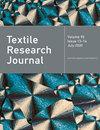深度学习和人工智能在染色、印花和后整理中的应用综述
IF 1.9
4区 工程技术
Q2 MATERIALS SCIENCE, TEXTILES
引用次数: 0
摘要
本综述侧重于深度学习和人工智能在纺织品染色、印花和后整理领域的变革性应用。在纺织品染色方面,主题涵盖颜色预测、基于颜色的分类、染色配方预测、染色模式识别,以及色彩织物疵点检测的细微领域。在纺织品印花方面,人工智能和机器学习的应用主要围绕印花织物的图案检测、新图案的生成以及检测印花织物疵点的关键任务。在纺织品整理方面,讨论了织物热固性参数的预测。人工神经网络、各种卷积神经网络变体(如 AlexNet)、传统机器学习方法(包括支持向量回归、主成分分析、XGBoost)、生成式人工智能(如生成式对抗网络)以及遗传算法都在这一多方面的探索中得到了应用。使用这些方法的核心原因是需要最大限度地减少重复、耗时的人工任务,降低原型设计成本,促进流程自动化。审查揭示了大量创新架构和框架,每种架构和框架都是为应对特定挑战而量身定制的。然而,一个长期存在的障碍--数据稀缺,仍然是一个重大障碍。在揭示一系列研究成果的同时,综述还强调了在纺织印染领域实施人工智能解决方案所面临的固有挑战。本文章由计算机程序翻译,如有差异,请以英文原文为准。
A review of deep learning and artificial intelligence in dyeing, printing and finishing
This review focuses on the transformative applications of deep learning and artificial intelligence in textile dyeing, printing, and finishing. In textile dyeing, the topics span color prediction, color-based classification, dyeing recipe prediction, dyeing pattern recognition, and the nuanced domain of color fabric defect detection. In textile printing, applications of artificial intelligence and machine learning center around pattern detection in printed fabrics, the generation of novel patterns, and the critical task of detecting defects in printed textiles. In textile finishing the prediction of fabric thermosetting parameters is discussed. Artificial neural networks, diverse convolutional neural network variations like AlexNet, traditional machine learning approaches including support vector regression, principal component analysis, XGBoost, and generative artificial intelligence such as generative adversarial networks, as well as genetic algorithms all find application in this multifaceted exploration. At its core, the interest to use these methodologies is because of the need to minimize repetitive and time-consuming manual tasks, curtail prototyping costs, and promote process automation. The review unravels a plethora of innovative architectures and frameworks, each tailored to address specific challenges. However, a persistent hurdle looms – the scarcity of data, which remains a significant impediment. While unveiling a collection of research findings, the review also spotlights the inherent challenges in implementing artificial intelligence solutions in the textile dyeing and printing domain.
求助全文
通过发布文献求助,成功后即可免费获取论文全文。
去求助
来源期刊

Textile Research Journal
工程技术-材料科学:纺织
CiteScore
4.00
自引率
21.70%
发文量
309
审稿时长
1.5 months
期刊介绍:
The Textile Research Journal is the leading peer reviewed Journal for textile research. It is devoted to the dissemination of fundamental, theoretical and applied scientific knowledge in materials, chemistry, manufacture and system sciences related to fibers, fibrous assemblies and textiles. The Journal serves authors and subscribers worldwide, and it is selective in accepting contributions on the basis of merit, novelty and originality.
 求助内容:
求助内容: 应助结果提醒方式:
应助结果提醒方式:


